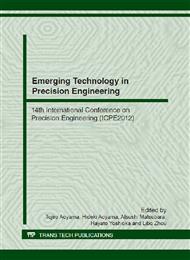p.244
p.250
p.256
p.262
p.267
p.272
p.276
p.281
p.287
Material Removal Rate Control in Open-Air Type Plasma Chemical Vaporization Machining Using Optical Actinometry
Abstract:
Open-air type numerically controlled plasma chemical vaporization machining (NC-PCVM) is promising technique to fabricate the ultra-precision optical components and to finish the functional materials. The objective shape is fabricated by controlling the scanning speed of the localized plasma because removal volume is proportional to the dwelling time of the plasma on the workpiece surface. To achieve deterministic figuring with shape accuracy of nanometer level, it is essential to keep volumetric material removal rate (MRR) constant during and batch to batch processing. The removal rate is proportional to the density of fluorine radical generated by plasma. So, we control the electric power to keep the removal rate constant during the process based on the fluorine atomic density obtained by optical emission actinometry. We report the relationship between MRR and fluorine atomic density measured by optical emission actinometry.
Info:
Periodical:
Pages:
267-271
Citation:
Online since:
November 2012
Authors:
Price:
Сopyright:
© 2012 Trans Tech Publications Ltd. All Rights Reserved
Share:
Citation:


